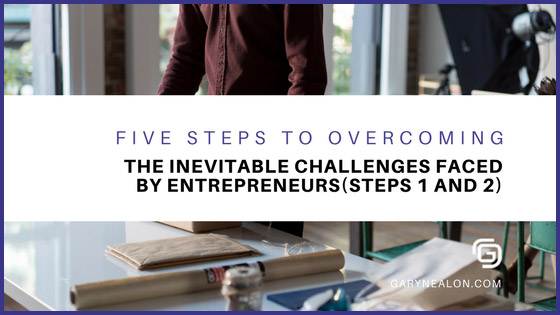“Out of adversity comes opportunity”
– Benjamin Franklin
Growing up, I always knew that I wanted to be an entrepreneur.
But when you’ve got a huge dream and an even bigger vision; you don’t always think about the challenges that could arise along the way. Like many entrepreneurs, I had to learn a lot of things the hard way, but it didn’t take long for me to discover the truth. In the world of business, things can go south fast –real fast.
Take my first real business venture. I had a business plan and ideas that had made it past the dream stage. I’d even obtained funding. In the end, though, it failed –miserably. I’d accrued a lot of debt –to the tune of more than one million dollars. Eventually, I had no choice but to file for bankruptcy.
They say that you learn from experience. And as clichéd as it sounds, I did discover several lessons –both from my failed business venture and from the success of several subsequent companies that I would go on to start.
Ever since I discovered –and first began implementing them, these lessons have come to my assistance time and time again. My hope is that you can learn from my experience –and apply these tips to your own business, using them to overcome many of the common challenges that arise.
Who knows? They may even save you from having to learn things the hard way.
But first, let’s take a look at perhaps one of the biggest challenges that any entrepreneur will face in their journey –the temptation to throw in the towel.
“I QUIT! NO, WAIT I’M NOT A QUITTER”
It’s possible that you yourself have been in the same position that I was when I witnessed the collapse of my company.
Nothing prepares you for that day that you realize there’s no turning back. That the company you worked so hard to establish is now over. It’s one hell of an emotional roller coaster and something that I wouldn’t wish upon anyone.
To expand upon the quote from Benjamin Franklin, though, it’s sometimes through adversity that we learn our greatest lessons. For me, the lesson that I learned through my failure, was the importance of never giving up. Even when things looked their bleakest, I still felt, deep inside of me there was another opportunity, although it sure didn’t look like it at the time.

Maybe you know that feeling I’m talking about –perhaps it’s something that your coach or a parent instilled in you when you were young. At basketball practice, there were times that I would make a mistake, or fail when we were running a drill. The coach would blow the whistle and start to yell.
In a brief moment, I’d feel tempted to slam the ball on the floor and leave the court, but I knew that if I just walked away the coach would look at me and yell, “Gary what the hell are you doing, get your ass back on the court, there are no quitters here!”
Years later, when my company would began to collapse, it was a similar situation –and it elicited the same fight-or-flight response. At the time, I felt largely out of control –and in many ways I was. Because I had an import business, my product cost was largely determined by the price of oil. When oil increased dramatically, my cost of goods sold skyrocketed to the point where I could no longer make a profit.
No matter what industry you’re in, one thing is certain: you need to be prepared mentally and expect adversity to come. As your business grows, a certain amount of failure is inevitable. Sometimes it’s due to unforeseen circumstances, other times –it may be entirely your fault.
As a leader though, it’s important to accept full responsibility for every setback, and then take the helm and find a solution. Just keep in mind that the answer may be different from what you might expect. It may come in the form of a new approach, heading a different direction, or even launching an entirely new company.
Over time, I’ve realized that there are always challenges –and it’s best to go into anything, a new venture, a basketball game, a partnership –with your eyes wide open to the difficulties that lie ahead. Mistakes, will happen, roadblocks will come up. What matters is not so much what takes place, but how you respond to it. Things won’t always be easy, but we will survive, and live to fight another day.
“When adversity comes, and it will, learn to respond to it and not react to it. It will make a smoother transition to the solution”
–Gary Nealon
Step #1: See If You Can Automate It
Technology is amazing, and I would not be where I am at today without it.
In order to stay competitive in today’s global marketplace, you’re going to want to take advantage of every opportunity to simplify, automate, and save time –all things that technology helps to facilitate.
Take, for example, list building –or, compiling an email mailing list. When I first discovered list building, I knew that there had to be an easier way to send emails to all the potential clients that had become part of our list. Back in 2006, there weren’t as many options as there are today. Eventually, though, we found a way to send multiple emails at one time to many different people –something that was almost unheard of back then.
As my company, RTA Cabinets continued to evolve, we also began to implement market diversification; or, using different channels to promote and sell our products. However if you’re not careful, having your product listed in multiple channels, can quickly turn into a logistical nightmare.
The software platforms that we were using weren’t always compatible with our primary inventory system. Trust me, it’s no fun when you have three customers order the same product on the same day, from different platforms, expecting delivery in two weeks and you only have one product in stock in your warehouse.
So the search began to find a software program that would bring all of these inventory systems together. But we couldn’t find one that fit our needs. The solution, we realized, was to create our own proprietary software –a task that we would soon learn was to present its own set of challenges.
As we got to work; streamlining, adjusting, and tweaking our software; we ended up needing to overhaul and re-engineer it a number of times. Back to the drawing board we would go, again. We had to put the Red Bull delivery driver on speed dial just to meet the needs of our overworked programmers!

In the end, though, we managed to create our finished product. The end result was Datafeed Automation; a software program that’s able to streamline multiple selling platforms, making it easy to manage order fullfilment and inventory. For example, if you’re selling on Amazon as well as your company website, Datafeed can help. Currently, the software is coming out of beta testing and is ready for the public.
I firmly believe that for startups today, automation isn’t just a good idea –it’s vital; especially once you begin to scale your company.
When you automate, you create a solution that requires little or no human interaction to execute but does so in an efficient manner that achieves the outcome that you are looking for. The result is ability to streamline your process and remove the guesswork from many time-sensitive tasks, allowing you to compete at a national or even global level. For us, the fact that we were able to turn our automation system into a patented program was just the icing on top.
Step #2: Get The Facts Before Making A Decision
If you’re a business owner, there will come a day when you’ll receive a phone call at an unusual hour.
It may be later in the evening, or on a weekend –while you’re working to take care of some business from the week.
The phone rings, and you answer. Chances are it’s either an employee or a vendor; maybe it’s a customer. The voice on the other line speaks out, answering in a tone that’s full of fear and dread. “We….we have a problem,” they say. Your heart sinks as you wonder, “What could it be!?”

This is a phone call that I’ve received countless times. And it’s a call that you have to be prepared for as a business owner. Sometimes the news is minor –maybe a customer didn’t receive their order, despite the fact that you mailed it out earlier in the week. Other times, though, it could be something more major.
I once had the FBI come to my office to question me about a former employee, who had embezzled $200k worth of inventory from me. That’s a serious scenario –the kind that makes you question everything you know, and wonder whether or not you have enough money saved to retire to the Caribbean.
No matter what your bad news situation is, though, there’s one thing that you should always do. Before your mind starts spinning with worst-case-scenarios and potential problems, it’s important to step back, and take the time to gather all of the facts.
Now, when your mind’s whirling, the last thing you’ll want to do is to start playing detective, but you’re going to have to do some sleuthing if you want to make proactive, fact-based decisions; rather than kneejerk reactions.
Tom Villante, CEO of fintech company YapStone, agrees.
“Entrepreneurs are very passionate people and it’s easy to make a decision when you’re riding high or running low,” Villante says. “Do yourself a favor — don’t.”
“Emotional decisions tend to yield undesirable outcomes,” he continues. “Logic takes a backseat, and the risk you’re willing to take may be too much. If you’re hyped up, chances are you need to take time to check your emotions, gather the facts and then make the best decision possible.”
When a crisis hits, stop. Pause for a minute. Ask questions, gather data, and ask different people. The right question asked to the right person at the right time, will sometimes lead to the best solution.
You can get the facts by asking:
- When did it happen?
- Where did it happen?
- Who was there when it happened?
- What happened?
- How did it happen?
Visualizing Colombo yet?
This is always a good starting point when it comes to gathering facts about a problem. Asking these questions may not give you a solution right away. But it will point you in the right direction. The answers to one or more of the questions will help you uncover a layer of the problem and once another layer of the problem is answered, you guessed it; you can ask the questions again, until you gather enough facts to move on towards a solution.
These first two steps that we’ve looked at; automation and fact-gathering, are about acknowledgment and discovery.
Once you see a problem, it’s a good idea to ask yourself if it’s something that can be solved by automation. This will help to get your wheels turning; getting you into problem-solving mode and allowing you to immediately start moving towards a solution.
As for situations when you receive bad news, by searching for the facts, you’ll be able to save time and energy that would otherwise have been wasted on needless speculation and worrying about scenarios –many of which will never pan out. Soon, you’ll have the information that you need to make fact-based decisions, putting you back in control.
One of the greatest traits of entrepreneurs is that we are finishers. We complete what we start. Even if in the end, we have to change course, or pivot somewhat from our original idea.
“In my pursuit of greatness, I have learned that the mind can be your greatest friend or your strongest adversary. But the mind of a trusted friend is always the great reconciler of the two.”
–Author Unknown
As entrepreneurs, we’re always going to face challenges. But one thing that separates the ones who succeed –from those who don’t is resilience, and an unwillingness to give up.
Step #3: Enlist Outside Help
As business owners, we’re subjected to a curse –we feel like we have to do it all, and be the ones to come up with all the answers.
The truth though, is that sometimes a little bit of outside intervention is the best thing that can happen to us. I can’t begin to count the number of times that it’s helped me. Often, when I’m battling a problem, the moment I run it by someone I trust, their feedback immediately leads to the solution I had been struggling to find.
Almost every great business leader will tell you that they surround themselves with talented people. They may have been the mastermind behind the successful product, but they had support along the way that contributed to their company’s success.
As Albert Einstein once said, “We can’t solve problems by using the same kind of thinking we used when we created them.” Sometimes seeking advice from someone who’s not knee deep in the problem is the best thing that you can do.
On the days when I am faced with a problem or an obstacle that needs to be addressed, usually, I’ll check to see if the solution can be automated. Then I’ll gather all the facts. After that, I’ll generally seek outside help; either by asking team members, trusted friends, mentors, or members of my mastermind group.
The three questions I’ll ask usually include a variation of the following:
- “What am I missing?”
Having a second pair of eyes or ears can help to highlight a different perspective or angle on something. It can also expose flaws in your thinking, or areas where you may have a blind spot. - “What am I overlooking?”
This is similar to the first question, but asking this question will sometimes help to get people’s wheels spinning in a different direction. - “What would you do if you were in my shoes?”
This question is something that I will often ask my mentor or another leader. This question is a judgment call; you’ll learn when it’s appropriate to ask.
By asking these questions to people who are familiar with the problem and especially to those that you have a working relationship with, you’re going to get answers.
But more that, you’ll also empower your team to become effective problem-solvers themselves; training them to ask these questions about issues that they’re facing; to help them find solutions. Instead of having to ask you for things, they’ll be able to work more efficiently and make more independent decisions, and that efficiency is like depositing money in the bank.
Step #4: Think Outside The Box
It’s safe to say that as startups, we operate on overdrive.
As a business owner, you are constantly facing a barrage of decisions that need to be made. When seeking solutions, it can be tempting to go with the easiest one –the ‘quick fix,’ if you will. After all, time is of the essence, and it’s one thing that we’re always short on. But sometimes, the easiest solution isn’t always the best one, especially in the long run.
When faced with a challenge, it’s important to think about your company as a growing entity, and look to make decisions that will make a difference, not only immediately, but in the long-term as well.
The solution when your company is at 30 sales a day isn’t always going to necessarily be the best option for when you are making 300 sales a day. That is why it is important to think outside the box, and to keep scalability in mind.
When assessing potential solutions, ask yourself:
- “Will this solution compromise our company values?”
- “Will this solution let our customers down?”
- “Is this solution a Band-Aid fix, rather than something that will address the main issue?”
- “Is this solution a small-business fix –something that will work as a patch, but won’t hold as the company continues to grow?”
If the answer to any of these questions is ‘yes,’ then it may be time to reconsider –to go back to the drawing board and find another solution.
Another way to look at this is to challenge yourself and your team. Is there another way? An alternative solution? Is there something that you haven’t tried before?
It’s important to realize that the answer may not come right away. When there’s a problem that you need to come up with an answer or solution as quickly as possible, but when the ‘solution’ is a poor fit, it could end up making the problem worse.

I’ve found that the answer will often come when you least expect it. There have been many times that I’ve been faced with a problem, and unable to find a solution. But then, when I’m driving or sitting at home watching the game, suddenly the answer will come to me –unexpectedly. Or the phone will ring and it’s one of my team who has a solution.
Perhaps you’ve had ideas come to you when you’re distracted, or away from the job. Sometimes taking the time to step back from the problem is exactly what it takes to help you think more clearly. In fact, some studies explain that there may be a scientific reason for this –a combination of distraction, dopamine, and being in a relaxed state of mind all combine to create the perfect environment for creativity.
It’s all about digging deep –and refusing to compromise. Always seek solutions that are long-term; ones that will serve as a lasting solution, while allowing you to keep your values and your customers at the forefront of everything that you do.
“Solutions nearly always come from the direction you least expect, which means there’s no point trying to look in that direction because it won’t be coming from there.”
–Douglas Adams
Step #5: Delegate
Flip open any management book and you’ll find a section on delegating. It’s something that’s talked about an awful lot, but often never happens.
As entrepreneurs, we struggle with delegating.
In fact, did you know that 98 percent of entrepreneurs say that their biggest challenge is doing everything themselves and not having enough time? The reason, of course –is because we’re trying so hard to do everything ourselves!
There’s a lot at stake, we’re always buried with work, and naturally, we want to stop things from going wrong. Most of us are wired to do the work ourselves rather than handing it off to someone else.
We often get caught up in doing tasks that don’t add value, or that we don’t think anyone can do at the same level as ourselves. But micromanaging isn’t the answer. That’s just creating a business that’s dependant on you –and that’s the fastest way drive yourself into the ground.
The solution, then, is being able to delegate. Why? Simple: so you don’t push yourself to the point of burnout, and so you can expand your company further than you could on your own.
When you start to delegate lower level tasks, it frees up your time to focus on the tasks that bring the highest value or ROI for your company.
I should know. I was stuck in this circle of spinning my wheels, doing many tasks that a virtual assistant could have done. Once I made the shift; and began outsourcing, it helped our company to grow exponentially. In fact, I think at this point, I’ve almost worked myself out of a job –by letting others who may be more skilled at certain tasks, take them over.
“Your most important task as a leader is to teach people how to think and ask the right questions so that the world doesn’t go to hell if you take a day off,” says Jeffrey Pfeffer, author of What Were They Thinking?: Unconventional Wisdom About Management.
Although it can be difficult, it’s important to learn how, and when to outsource.

When I’m faced with a challenge these days, the first thing that I do after coming to a favorable solution, is to delegate it to one of my team members, or outsource it to a trusted vendor. I’ve learned that is most cases, this is by far the most efficient solution; and the best way to ensure that the job gets done –and to a high standard!
Many times this can be difficult for an owner to do because often there is a lot at stake if something goes wrong again and it is just naturally the persona of many owners to take control and see it through to the end. But trust me when I say, there will always be another problem that will come along –for you to put time into if you wish.
More importantly though, your time would be much better spent focusing on other areas of your company. You’re a leader. Trust your instincts, and trust your people to implement the strategy or procedure necessary to get things back on track.
In any scenario, communication is always going to be one of the primary keys to solving the problem. Good communication involves being clear and upfront about your expectations; and always avoids passing the buck.
Effective communication will also help to keep misunderstandings at bay. I hold weekly meetings with my team to discuss any challenges that have taken place, and to go over the solutions that we’ve come to, as well as the wins that came as a result of making corrections and adjustments.
Below are the five steps again:
- SEE IF YOU CAN AUTOMATE IT
- GET THE FACTS BEFORE MAKING A DECISION
- ENLIST OUTSIDE HELP
- THINK OUTSIDE THE BOX
- DELEGATE
The five steps will lead to additional questions and further dialogue with you and your team. While the issues and challenges you face may be unique to your industry or niche, these steps are universal and can serve as a solid foundation to work from.
Strategizing isn’t always about coming up with the newest marketing campaign. Sometimes –and frequently when you’re an entrepreneur, it involves problem-solving.
Your success will, in large part, be determined by how you respond to the challenges that arise.
I look forward to hearing how these five steps contribute to the success of your business.
Have you implemented any of the above steps in problem-solving? What’s your go-to problem-solving strategy when a challenge arises?







1 thought on “Five Steps to Overcoming The Inevitable Challenges Faced by Entrepreneurs (Steps 1 and 2)”